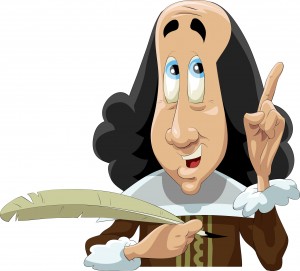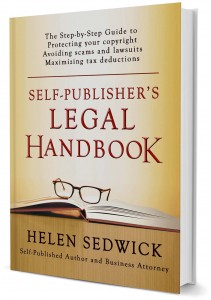 Their works have spawned countless remakes and retellings. Stately manor houses have been transformed into zombies hideouts. Characters have been transported to New York tenements. Star Trek’s Klingons recite Hamlet’s soliloquies.
Their works have spawned countless remakes and retellings. Stately manor houses have been transformed into zombies hideouts. Characters have been transported to New York tenements. Star Trek’s Klingons recite Hamlet’s soliloquies.
And since Shakespeare and Austen’s works are in the public domain, all of these remakes are legal.
Books, settings, characters, and stories in the public domain are a rich source of material for writers, as they should be. When a classic tale is retold, writers explore timeless yearnings and connect us to our past. West Side Story remains as tragic as Romeo and Juliet, and A Thousand Acres by Jane Smiley adds modern tensions to King Lear.
On the legal side, however, many writers are tentative about basing their stories on public domain works. Will they own any copyright in the work or will it remain in the public domain? The answer is a little of both.
What is in the Public Domain?
There are four major categories of public domain works.
- Works that are not copyrightable. Ideas and concepts alone are not protected by copyright and are in the public domain. This includes stock characters, such as the handsome but dull hero and the tough-talking villain, and generic settings, such as gritty streets or deep space expanses.
- Works created by U.S. government employees, for example, the famous Depression era photos taken by Dorothea Lang when she was employed by the WPA.

- Works donated to the public domain through a Creative Commons license.
- Works where the copyright has expired.
As of today:- The copyright on works first published in the United States before January 1, 1923 has expired, and writers may use these works without permission.
- Thanks to Congress passing laws to favor Disney and other corporate copyright owners, the copyright on works published on and after January 1, 1923 won’t start expiring until 2019.
- For works published after 1977, the copyright won’t expire until 70 years after the author’s death.
- For works published between 1923 and 1977, the expiration depends on whether a copyright notice was properly placed, whether the copyright was registered, and whether the registration was renewed. You may need a lawyer or professional copyright researcher to sort it out. The duration of copyrights for works created in different countries may be different.
For this article, I am focusing on works with expired copyrights, such as Jane Austen’s Pride and Prejudice, published in 1813.
How Many Times Can Pride and Prejudice be Retold?
Every year, publishers release dozens of books based on the story of Elizabeth Bennett, Mr. Darcy, Lady Jane and Charles Bingley. At least three films are based on the novel, not to mention a several television series. How does this work? Don’t the copyright claims conflict?
They don’t because each creator has a copyright interest only in the new material created by that creator, the rest remains in the public domain. When Helen Fielding transformed Austen’s work into Bridget Jones Diary, her new material was protected by copyright, not the underlying story lifted from Austen’s novel. When filmmakers release yet another Midsummer Night’s Dream, they own the copyright to the dialogue, costumes, sets, and all other new creations, not Shakespeare’s words.
Whether the new work lifts entire sections without change, or alters every word of the original, no one may claim an exclusive right to use Shakespeare’s or Austin’s words, characters, names, settings, or the storyline. No one can revive the copyright on Mr. Darcy or Lady Jane by casting them in a new light. The same with Dracula, King Arthur, Huckleberry Finn, and the Cheshire Cat.
 A perfect example is Seth Grahame-Smith’s mash-up novel, Pride and Prejudice and Zombies. The author transported the characters, setting and storyline to an alternate world where zombies routinely devour proper ladies and gentlemen out for afternoon strolls. The book hit the New York Times Bestseller’s List and has spun off video games. A film version is in the works.
A perfect example is Seth Grahame-Smith’s mash-up novel, Pride and Prejudice and Zombies. The author transported the characters, setting and storyline to an alternate world where zombies routinely devour proper ladies and gentlemen out for afternoon strolls. The book hit the New York Times Bestseller’s List and has spun off video games. A film version is in the works.
But no matter how money is invested in and made from Pride and Prejudice and Zombies, Grahame-Smith has no copyright interest in any of Austen’s original work. Writers are free to take her characters to another time or universe. And they do.
Writers should not discount the potential of using public domain works for inspiration, characters, story lines and structure. The market for remakes seems insatiable.
How to Use Public Domain Work
Go back to the source. If you are going to base a story on a public domain work, go back to original work if possible. Don’t base your story on another writer’s retelling or the movie version, since those are likely to mix copyrighted and public domain material. If you are using a translation, do not use the specific language of the translation (which may be covered by copyright) and stick to the larger components such as the story line and characters. Similarly, don’t use any illustrations, commentary and annotations added since 1922, since those may also be protected by copyright.
Don’t be fooled by bogus copyright notices. If you pick up a print copy of Pride and Prejudice, you are likely to see a copyright notice in the name of the publisher together with the usual statement “No part of this publication may be reproduced…” Many of these notices are bogus; the publisher cannot claim any copyright on the public domain work. It’s illegal, although no one is enforcing those laws.
A publisher has a copyright claim only in new material, such as an introduction, illustration, or commentary. To be protected by copyright, the added material must have some level of originality. Merely changing English spelling to American spelling does not create a new copyright claim. Digitizing a printed book is not a new copyrightable work.
The proper copyright notice limits the claim to the new material. For example:
- Translation © year and name of translator;
- Illustrations © year and name of illustrator;
- Introduction © year and name of writer of introduction.
Use the proper copyright notice on your own work. Your copyright notice should claim rights only in your new work. There is no required form, but consider something along these lines.
© year and your name. This novel is based on The Iliad, and no copyright is claimed on any material in the public domain.
How to Register the Copyright to the Work
If you create a new work based upon public domain material, you have created what the Copyright Office calls a “Derivative Work.” You may register the copyright to a Derivative Work, similar to any other original work. Your registration is still under your name as the Author and Claimant (not Jane Austen) and the date of first publication is the date you first publish your derivative work. The Copyright Office, Circular 14, provides instructions.
Here are some of unusual remakes:
- Manga Shakespeare, Shakespeare plays and other classics as graphic novels.
- Frankenstein: A BabyLit Anatomy Primer, a board book.
- Hamlet’s soliloquies translated into Klingon, on YouTube.
Feel free to add to this list.
(This post originally appears on Joel Friedlander’s TheBookDesigner.com as How Romeo and Juliet Can Help You Write Your Next Book.)
SHARE THIS




